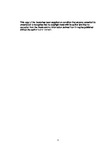The effects of a variation in noseband tightness on the rein tension of the ridden horse.
| dc.contributor.supervisor | McGregor, Peter | |
| dc.contributor.author | Duke, Deborah | |
| dc.contributor.other | School of Biological and Marine Sciences | en_US |
| dc.date.accessioned | 2017-11-16T13:34:44Z | |
| dc.date.available | 2017-11-16T13:34:44Z | |
| dc.date.issued | 2017 | |
| dc.date.issued | 2017 | |
| dc.identifier | 10063622 | en_US |
| dc.identifier.uri | http://hdl.handle.net/10026.1/10168 | |
| dc.description.abstract |
The noseband has been the topic of much recent attention from many within the equitation science field concerned with the welfare of the ridden horse. Nosebands have adapted over the years and are now used specifically for different purposes most being linked to increased control of the horse by either closing the mouth, placing additional pressure on the horse’s head in certain areas and preventing the horse avoid the pressure of the bit in their mouth. However, objective data do not exist on the consequences of tightening the noseband on the horse’s head. The possibilities are physical pain, skin and nerve pressure at an unacceptable level and an increased stress response as a result of the noseband pressure. The aim of this study was to compare the rein tension variations associated with a range of noseband fittings and the behaviours exhibited by a small sample of horses whilst wearing a cavesson noseband on three different levels of tightness. Fifteen horses were ridden around a predetermined route in a 25x45m arena, the rein tension was recorded with the ReinCheckTM during all observational periods. There were three replicates per horse covering loose, tight and normal noseband fittings. Data collated using SignalScribeTM were statistically analysed using a series of Friedman’s analyses and post-hoc Wilcoxon tests. There was a significant effect of noseband fitting on rein tension for the left rein: loose to normal (P<0.03; 17% increase in rein tension), loose to tight (P<0.01; 28% increase in rein tension) but not between normal and tight (P>0.05). For the right rein, rein tension only significantly increased between the loose and tight fitting (P<0.006; 24% increase in rein tension). Rein tension on the left rein in all conditions exceeded that on the right hand (P<0.001). No significant differences in rein tensions were associated with horse age (P>0.05). The results suggest that noseband fit and the associated increase in pressure does alter the rein tension recorded for that horse. Higher rein tensions were reported on the left rein, which could be related to rider or horse laterality. Further studies are required to fully elucidate the effect of noseband fit on rein tension and to inform industry guidelines. | en_US |
| dc.language.iso | en | |
| dc.publisher | University of Plymouth | |
| dc.subject | Rein tension | |
| dc.subject | Welfare | |
| dc.subject | Horse | |
| dc.subject | Equitation science | |
| dc.subject | Animal welfare | |
| dc.subject | Noseband | en_US |
| dc.subject.classification | ResM | en_US |
| dc.title | The effects of a variation in noseband tightness on the rein tension of the ridden horse. | en_US |
| dc.type | Thesis | |
| plymouth.version | publishable | en_US |
| dc.identifier.doi | http://dx.doi.org/10.24382/806 | |
| dc.rights.embargoperiod | No embargo | en_US |
| dc.type.qualification | Masters | en_US |
| rioxxterms.version | NA |
Files in this item
This item appears in the following Collection(s)
-
01 Research Theses Main Collection
Research Theses Main


